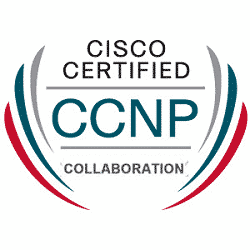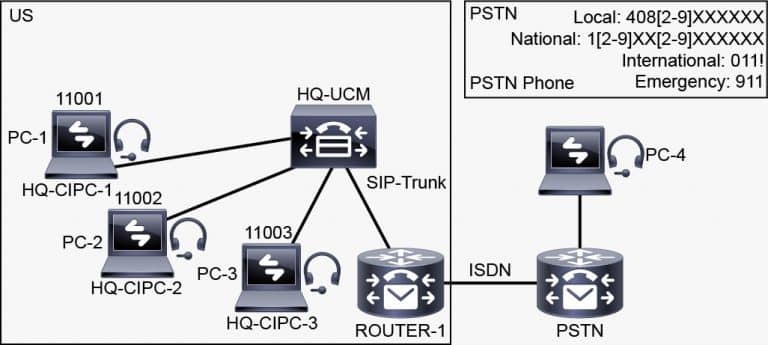CCNP Collaboration CLCOR – Implementing and Operating Cisco Collaboration Core Technologies

The CLCOR Implementing and Operating Cisco Collaboration Core Technologies Course represents the fundamental pillar of the Collaboration technology and certification path. In fact, it prepares the participant for the CCNP Collaboration Certification Core exam (Exam 350-801) . In this course, the necessary skills will be acquired to implement the fundamental Cisco Collaboration technologies, starting from the general study of the architectures up to the management and administration of Cisco Unified Communications Manager (CUCM) passing through MGCP gateways, Codecs, Cisco Jabber, QOS and QOS Models, Cisco VoIP Bandwidth Calculator, Toll Fraud Prevention and much more. The Course contributes to the preparation of the CCNP Collaboration Certification exam (Exam 350-801) .
Course Objectives
The following is a summary of the main objectives of the CLCOR Course Implementing and Operating Cisco Collaboration Core Technologies :
- Acquire skills to implement key Cisco Collaboration technologies.
- In-depth study of Collaboration architectures.
- Cisco Unified Communications Manager (CUCM) management and administration.
- Understanding MGCP gateways, Codecs and Cisco Jabber.
- In-depth look at QOS, Cisco VoIP Bandwidth Calculator, and toll fraud prevention.
- Develop proficiency in configuring and troubleshooting Cisco Unified Communications applications.
- Explore advanced features of Cisco Collaboration solutions, including integration with cloud services.
- Master techniques for monitoring and optimizing collaboration network performance and reliability.
Course Certification
This course helps you prepare to take the:
Exam 350-801 CLCOR Implementing Cisco Collaboration Core Technologies;
Course Outline
- Describing the Cisco Collaboration Solutions Architecture
- Overview of Cisco Collaboration Solutions Architecture
- Collaboration Deployment Models
- Licensing
- High Availability
- Capacity Planning
- Security Requirements
- Using Certificates
- Disaster Recovery
- Dial Plan
- IP Network Protocols
- Configure IP Network Protocols
- Codecs
- References
- Exploring Call Signaling over IP Networks
- IP Phone Initialization
- Single Site On-Cluster Calling
- Single Site On-Cluster Call Setup Troubleshooting
- Describe the Call Setup and Teardown Process
- Describe SIP Call Signaling for Call Setup and Teardown
- Configure and Troubleshoot Collaboration Endpoints
- Troubleshoot Calling Issues
- Compare the Call Control Protocols
- Describe DTMF Signaling over IP Networks
- References
- Integrating Cisco Unified Communications Manager LDAP
- Overview of LDAP Integration in Cisco Unified Communications Manager
- LDAP Synchronization in Cisco Unified Communications Manager
- LDAP Authentication in Cisco Unified Communications Manager
- LDAP Attribute Mapping in Cisco Unified Communications Manager
- LDAP Considerations in Cisco Unified Communications Manager
- Access Control Groups in Cisco Unified Communications Manager
- Feature Group Templates in Cisco Unified Communications Manager
- Configure and Troubleshoot LDAP Integration in Cisco Unified Communications Manager
- References
- Implementing Cisco Unified Communications Manager Provisioning Features
- Overview of Provisioning Options
- Deploy an IP Phone Through Auto and Manual Registration
- Self-Provisioning Prerequisites
- Self-Provisioning Components
- Self-Provisioning Authentication Modes
- Configure Self-Provisioning
- Batch-Provisioning Tools
- Configure Batch Provisioning
- References
- Exploring Codecs
- Define Codecs
- Compare Audio Codecs
- Compare Video Codecs
- Evaluate the Effects of Encryption on Codecs
- Explore the Cisco VoIP Bandwidth Calculator
- Describing Call Admission Control
- Configure Regions and Locations
- References
- Describing Dial Plans and Endpoint Addressing
- Dial Plan Overview
- Dial Plan Components and Their Functions
- Endpoint Addressing
- Overview of Cisco Unified Communications Manager Call Routing
- Cisco Unified Communications Manager Call-Routing Logic
- Address Methods and Digit Analysis
- Variable-Length Patterns, Overlapping Patterns, and Urgent Priority
- Implement Endpoint Addressing and Call Routing
- References
- Implementing MGCP Gateways
- Overview of MGCP Gateways
- MGCP Gateway Implementation
- Path Selection in Cisco Unified Communications Manager
- Route Groups
- Route Lists and Route Patterns
- Digit Manipulation in Cisco Unified Communications Manager
- Implement PSTN Calling Using MGCP Gateways
- References
- Implementing Voice Gateways
- Overview of Dial Peers
- Configure and Troubleshoot ISDN PRI
- Examine Cisco IOS Gateway Inbound and Outbound Dial-Peer Functions
- Digit Manipulation Features on Cisco IOS Gateways
- Implement and Troubleshoot Digit Manipulation on a Cisco IOS Gateway
- Codec and DTMF-Relay Selection on Cisco IOS Gateways
- References
- Configuring Calling Privileges in Cisco Unified Communications Manager
- Calling Privileges Overview
- Partitions and CSSs
- Partition and CSS Considerations
- Time-of-Day Routing
- Client Matter Codes and Forced Authorization Codes
- Configure Calling Privileges
- References
- Implementing Toll Fraud Prevention
- Toll Fraud Prevention Overview
- Cisco Unified Communications Manager CoS for Toll Fraud Prevention
- Implement Toll Fraud Prevention on Cisco Unified Communications Manager
- References
- Implementing Globalized Call Routing
- Overview of Multisite Dial Plans
- Globalized Call Routing Overview
- Globalized Call Routing Number Formats
- Globalization of Localized Call Ingress
- Localization During Call Egress
- Implement Globalized Call Routing
- References
- Implementing and Troubleshooting Media Resources in Cisco Unified Communications Manager
- Media Resources Overview in Cisco Unified Communications Manager
- Media Resource Selection and Access Control in Cisco Unified Communications Manager
- Describing the Annunciator Feature
- Describing Unicast and Multicast MOH Characteristics
- Audio and Video Conference Bridge Devices
- Audio and Video Conference Bridge Integration Options
- MTP and Transcoder Devices
- MTP and Transcoder Requirements
- References
- Describing Cisco Instant Messaging and Presence
- Describe Cisco IM and Presence Features and Architecture
- Compare the Protocols XMPP and SIMPLE SIP
- Clustering
- Describe Cisco Unified Communications IM and Presence Components and Communication Flows
- References
- Enabling Cisco Jabber
- Cisco Jabber Deployment Modes
- Cisco Jabber Operational Modes
- Deploy an On-Premise Cisco Jabber Client for Windows
- References
- Configuring Cisco Unity Connection Integration
- Overview of Cisco Unity Connection Integration
- SIP Integration
- Typical Integration Mistakes
- Integration Considerations
- Configure the Integration Between Unity Connection and Cisco UCM
- Manage Unity Connection Users
- References
- Configuring Cisco Unity Connection Call Handlers
- Call Handler Overview
- System Call Handler
- Caller Input
- Operator Call Handler
- Goodbye Call Handler
- Directory Handler
- Interview Handler
- References
- Describing Collaboration Edge Architecture
- Describe Collaboration Edge (Expressway-C, -E)
- Describe Supported Services for BB Collaboration
- Describe Prerequisites for Mobile and Remote Access
- Describe Service Discovery
- Explore Expressway Settings for MRA
- Describe Cisco Unified Border Element (CUBE)
- Analyzing Quality Issues in Converged Networks
- Converged Networks
- Available Bandwidth
- Components of Network Delay
- End-to-End Delay Calculations
- Jitter
- Packet Loss
- Defining QoS and QoS Models
- QoS Defined
- Network Traffic Identification
- Divide Network Traffic into Classes and Define Policies
- QoS Mechanisms
- QoS Models
- DSCP Encoding
- Expedited Forwarding and Assured Forwarding
- Class Selector
- Implementing Classification and Marking
- Classification and Marking Overview
- Classification and Marking at the Network and Data Link Layers
- QoS Service Class
- Cisco Marking Recommendations
- QoS Markings in a SIP Call Flow
- MQC Classification and Marking Options
- Configure QoS
- Configuring Classification and Marking on Cisco Catalyst Switches
- Campus Classification and Marking
- Overview of QoS Trust Boundaries
- Ingress QoS Models
- QoS Marking and Table Maps
- Internal DSCP
- References
Laboratory Activities
- Using Certificates
- Configure IP Network Protocols
- Configure and Troubleshoot Collaboration Endpoints
- Troubleshoot Calling Issues
- Configure and Troubleshoot LDAP Integration in Cisco Unified Communications Manager
- Deploy an IP Phone Through Auto and Manual Registration
- Configure Self-Provisioning
- Configure Batch Provisioning
- Explore the Cisco VoIP Bandwidth Calculator
- Configure Regions and Locations
- Implement Endpoint Addressing and Call Routing
- Implement PSTN Calling Using MGCP Gateways
- Configure and Troubleshoot Integrated Services Digital Network (ISDN) Primary Rate Interface (PRI)
- Examine Cisco IOS Gateway Inbound and Outbound Dial-Peer Functions
- Implement and Troubleshoot Digit Manipulation on a Cisco IOS Gateway
- Configure Calling Privileges
- Implement Toll Fraud Prevention on Cisco Unified Communications Manager (CUCM)
- Implement Globalized Call Routing
- Deploy an On-Premise Cisco Jabber Client for Windows
- Examine the Integration between Unity Connection and CUCM
- Manage Unity Connection Users
- Enterprise Application Integration (EAI): Configure QoS
Course Mode
Instructor-Led Remote Live Classroom Training;
Trainers
Trainers are Cisco Official Instructors and certified in other IT technologies, with years of hands-on experience in the industry and in Training.
Lab Topology
For all types of delivery, the Trainee can access real Cisco equipment and systems in our laboratories or directly at the Cisco data centers remotely 24 hours a day. Each participant has access to implement the various configurations thus having a practical and immediate feedback of the theoretical concepts.
Here are some Cisco Labs network topologies available:

Course Details
Course Prerequisites
Attendance at the Cisco CCNA Course is recommended .
Course Duration
Intensive duration 5 days
Course Frequency
Course Duration: 5 days (9.00 to 17.00) - Ask for other types of attendance.
Course Date
- Cisco CLCOR Course (Intensive Formula) – On request – 9:00 – 17:00
Steps to Enroll
Registration takes place by asking to be contacted from the following link, or by contacting the office at the international number +355 45 301 313 or by sending a request to the email info@hadartraining.com


